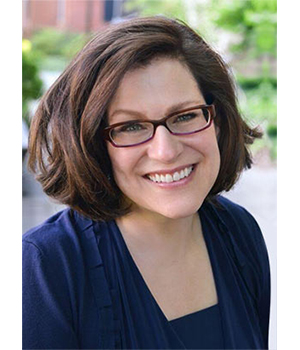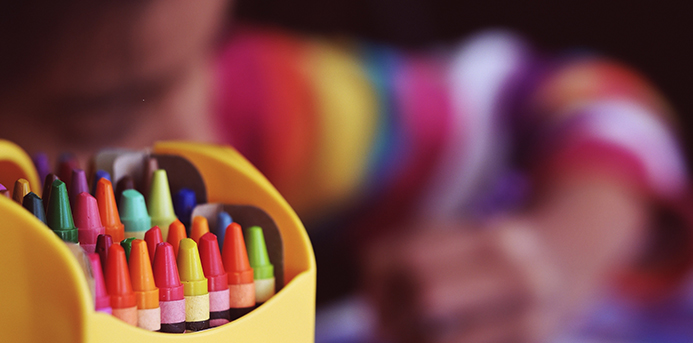
Erika Christakis, author and early childhood educator at the Yale Child Study, tells a tale of two preschool art projects. The first, we all know: a cut-out of your child’s handprint with feathers and eyes glued on to turn it into a Thanksgiving turkey. It’s cute. The second is less aesthetically pleasing — a blot of red on a page created with scraps of paper. The turkey represents an activity; a teacher helping trace then likely doing the cutting and laying out materials for children. It’s a top-down, teacher-directed way of learning.
The latter seems to represent nothing so much as wasted time — until we ask and listen. The child responsible for the red blob explained to Christakis, “This is Tyrannosaurus Rex meat. He’s a bad guy, a meat-eater with a big head and sharp teeth and real blood until he becomes just fossils which are old dead bodies stuck in the ground.”
“The conversation is a treasure trove of information about the boy’s pretend life and his family and humor,” Christakis says. But, more than that, she says it’s “emblematic of our mismatch in education wherein we give kids assignments and create their environments for them.”
Preschool Paradox
Christakis uses the term “preschool paradox” to explain how children are hardwired from birth to learn and yet are doing so poorly in our early educational settings. There are discipline problems, expulsions and frustrated parents. Why are we all struggling so much?
Christakis refers to the parenting book “All Joy and No Fun” which reverses the question of how what we do impacts kids and instead looks at how kids impact their parents. Our increasingly involved roles in our children’s lives are straining our own. Conversely, children are yearning for spaces where they can just be themselves.
Another paradox Christakis highlights is that young children are working more but learning less. In her book, “The Importance of Being Little: What Preschoolers Really Need From Grownups,” she says, “Schooling and learning are two different things. Young children aren’t blank slates … but, rather, they are complex persons who arrive already connected to families, communities and cultures — environments where they have done an awful lot of learning before they set foot through the door.”
What We Know and What We Don’t
When it comes to children, it’s easy to assume we know exactly what it’s like to be one — after all, we’ve all been there. Yet memory doesn’t serve us as accurately as we believe. No matter how we might squint, we’re still viewing the world through our adult lenses. “We have to suspend our arrogance that we know what it’s like to be a child,” Christakis says.
Emotionally, children are more similar to adults than we often think; they have complex and passionate feelings like jealousy and anger. Yet, cognitively, they are different. “After all, they believe that when they close their eyes, no one can see them,” Christakis says.
As adults, all we can do is get close to what it must be like to be a child. Christakis says that when we do, what we find is that children learn through play and meaningful relationships. “It’s easy to get wrapped up in the wrong things — class size, materials, and the like are only indirectly related to quality,” she says. “It’s symbolic fantasy play that elevates children cognitively and emotionally.”
And yet the natural habitat of childhood is being eroded. Our kids are spending less time outdoors and more time on screens. In addition, their play impulse is being constrained by their over-busy schedules.
How Can We Cultivate Play?
Tom Sawyer said, “Play consists of whatever a body is not obliged to do.” Christakis adds, “Trying to define play is like trying to define love; it’s too big for that.” She notes, though, that we can open up play through our use of language and materials. For example, instead of saying, “I like your drawing,” she suggests, “Tell me about the picture you drew.” It allows for a more open-ended conversation.
Simple materials like wooden blocks allow for adaptable play and infinite possibilities. When Christakis first began teaching preschoolers, her mentor said, “No Play-Doh; use clay instead. It’s messier and harder to work with. Give the kids two weeks to manipulate it without focusing on making something.” After 10 minutes — yielding to an adult impulse — Christakis said, “Let’s make Mother’s Day mugs.”
Instead, she says, if she’d followed a “meaning-based curriculum,” she would have allowed the children to explore so they could learn what happens when you: press your thumb into the clay; leave it out overnight; connect it to another piece of clay; add water. It’s the process of exploring, asking questions, and hypothesis testing. “We have to get used to the idea that kids might not come home with refrigerator art, but instead with dried-up misshapen lumps of clay,” Christakis says. It’s a focus on process over product.
The Five Cs
Christakis shares a method she uses to coach kids and get them into a deep learning zone. She calls it the “5 Cs” and briefly explains the steps:
1. Calibration is all about finding the right level; what do kids at this age do and what does this individual child need?
2. Coaching is helping each child reach the next level of learning without doing too much for them.
3. Communication involves a lot of listening and consideration of the emotional and cognitive life of each child.
4. Creativity is key; kids need to express themselves.
5. Connection is about being a responsive adult and validating our little charges as makers and creators.
It is our job to provide opportunities for our children to engage in more play, open-ended projects and social interaction. Christakis implores parents: “Get aggressive and don’t be afraid to push back with preschools to advance meaning- and play-based learning.” Her final advice? “Get your kids outside, even when it is cold!”
Erika Christakis spoke at a Family Action Network and Alliance for Early Childhood event in Wilmette in April. Visit the Alliance for Early Childhood site for information about upcoming events and their “ScreenBreak” initiative.
Want More?
- Read Christakis’ book, “The Importance of Being Little: What Preschoolers Really Need From Grownups”
- Visit her author site to learn more about the book and related articles
- Follow Christakis on Twitter @ErikaChristakis
FAN Annual Sponsors: Martin & Mary L. Boyer Foundation, Compass Health Center, Erikson Institute, Evanston Township High School, Make It Better, Mammal Foundation, New Trier Township High School, Pathways, Tina & Byron Trott
FAN Strategic Partners: Acclaim Media, Center for Talent Development at Northwestern University, Curt’s Cafe, Evanston/Skokie School District 65, Hackstudio, Loyola University Chicago School of Law, Master of Science in Education Program at Northwestern University, North Shore Community Bank & Trust, Northern Suburban Special Education District, New Trier Parent Association, Northwestern University, Redefined Fitness, The Book Stall, The Family Institute at Northwestern University, Y.O.U., YWCA Evanston/North Shore
FAN In-Kind Sponsors: Kirkland & Ellis, Turing Group
More from Make It Better:

